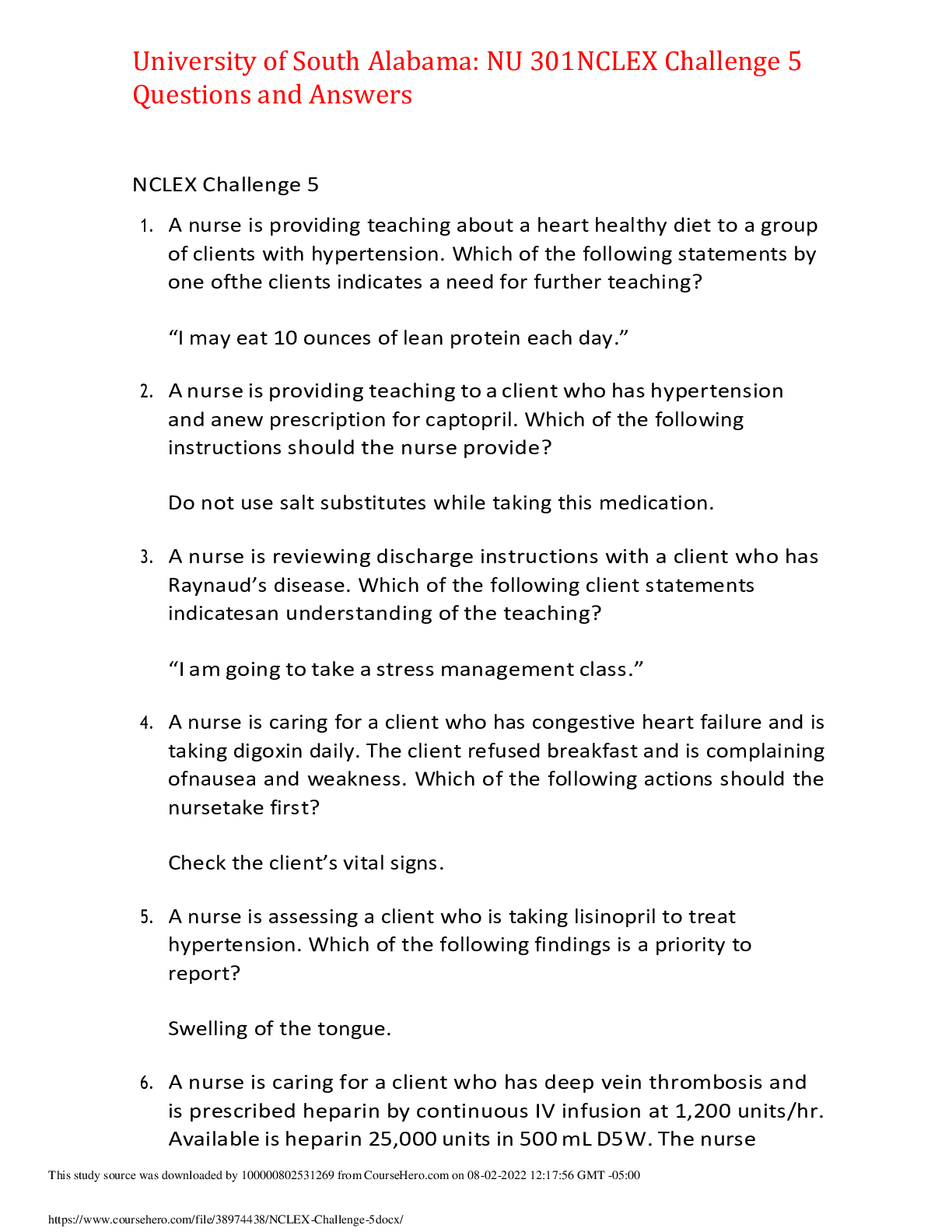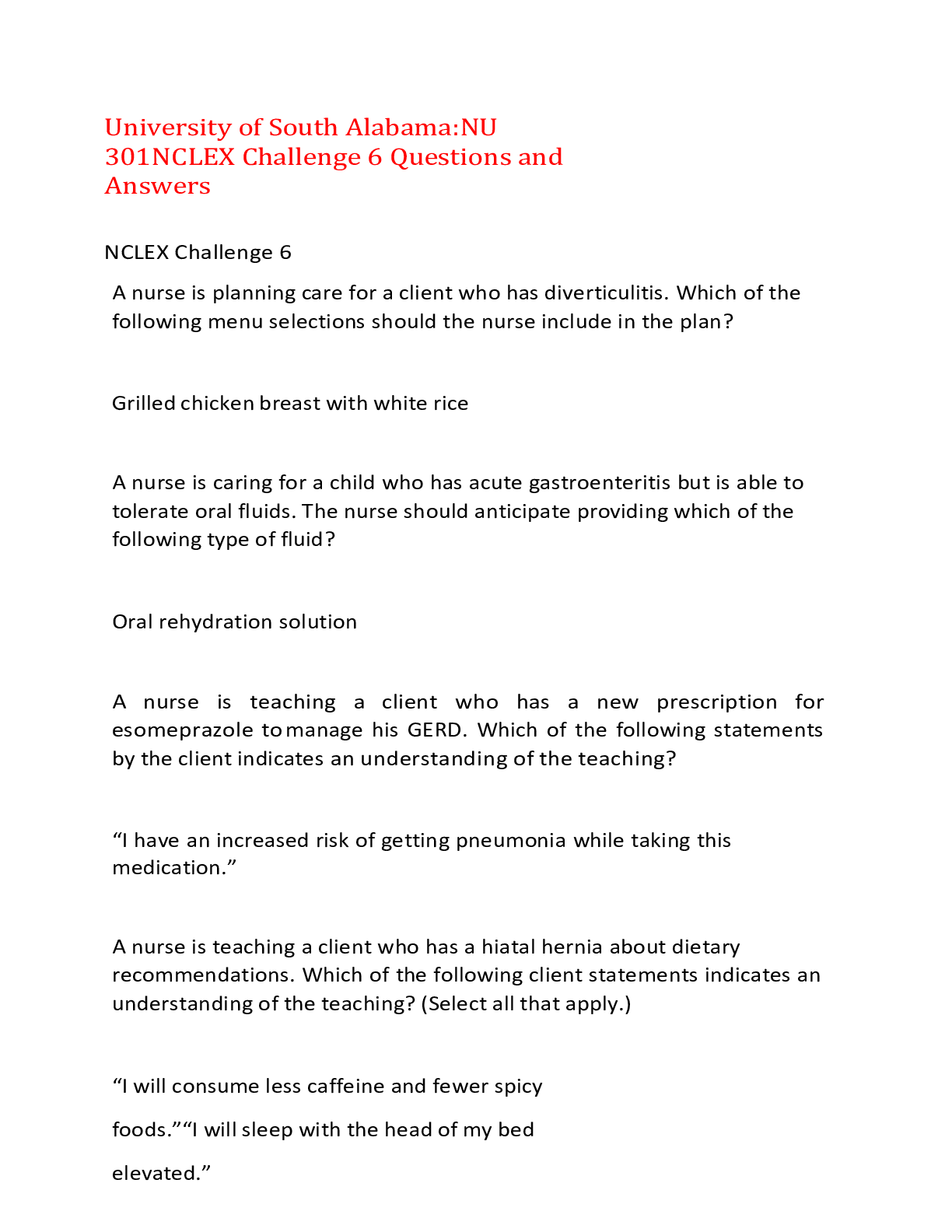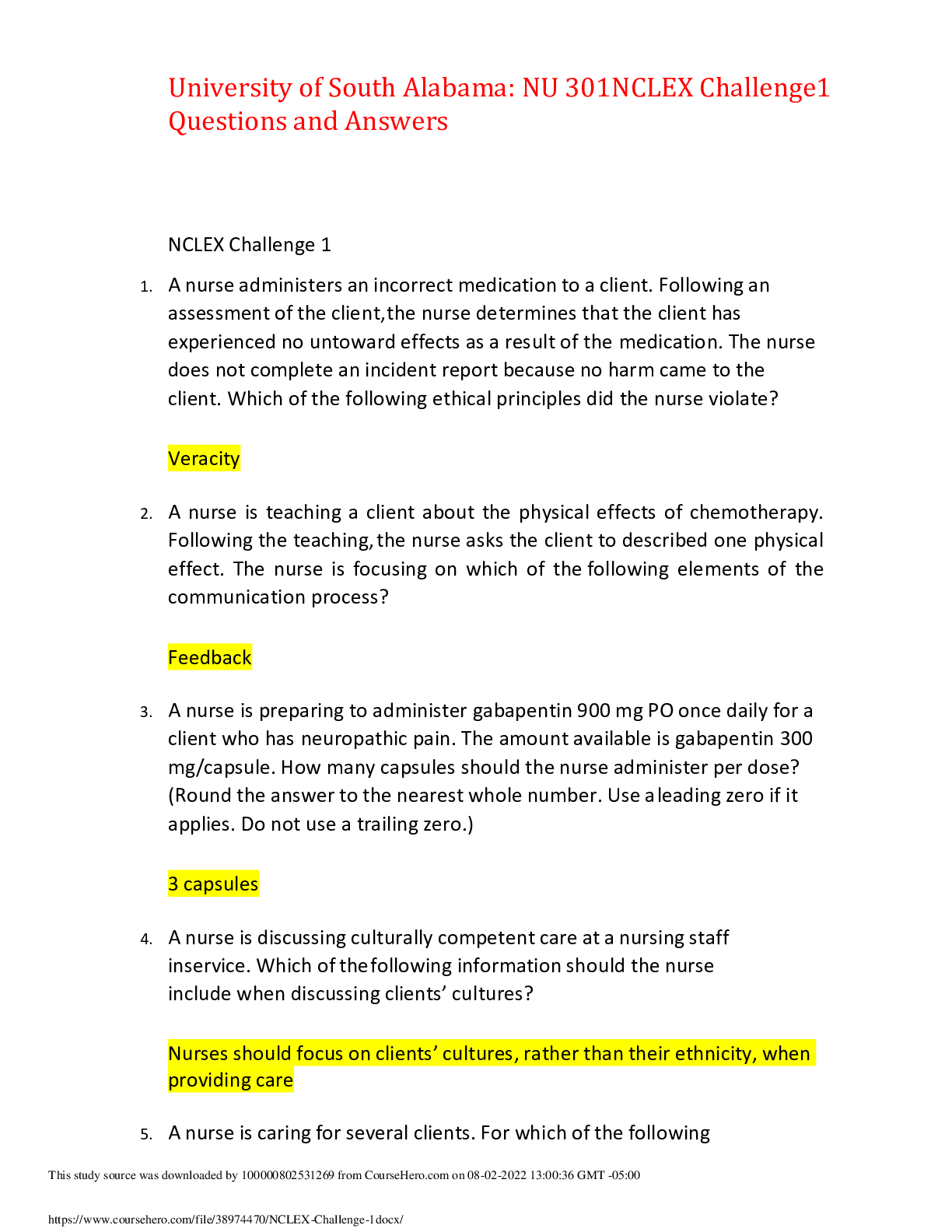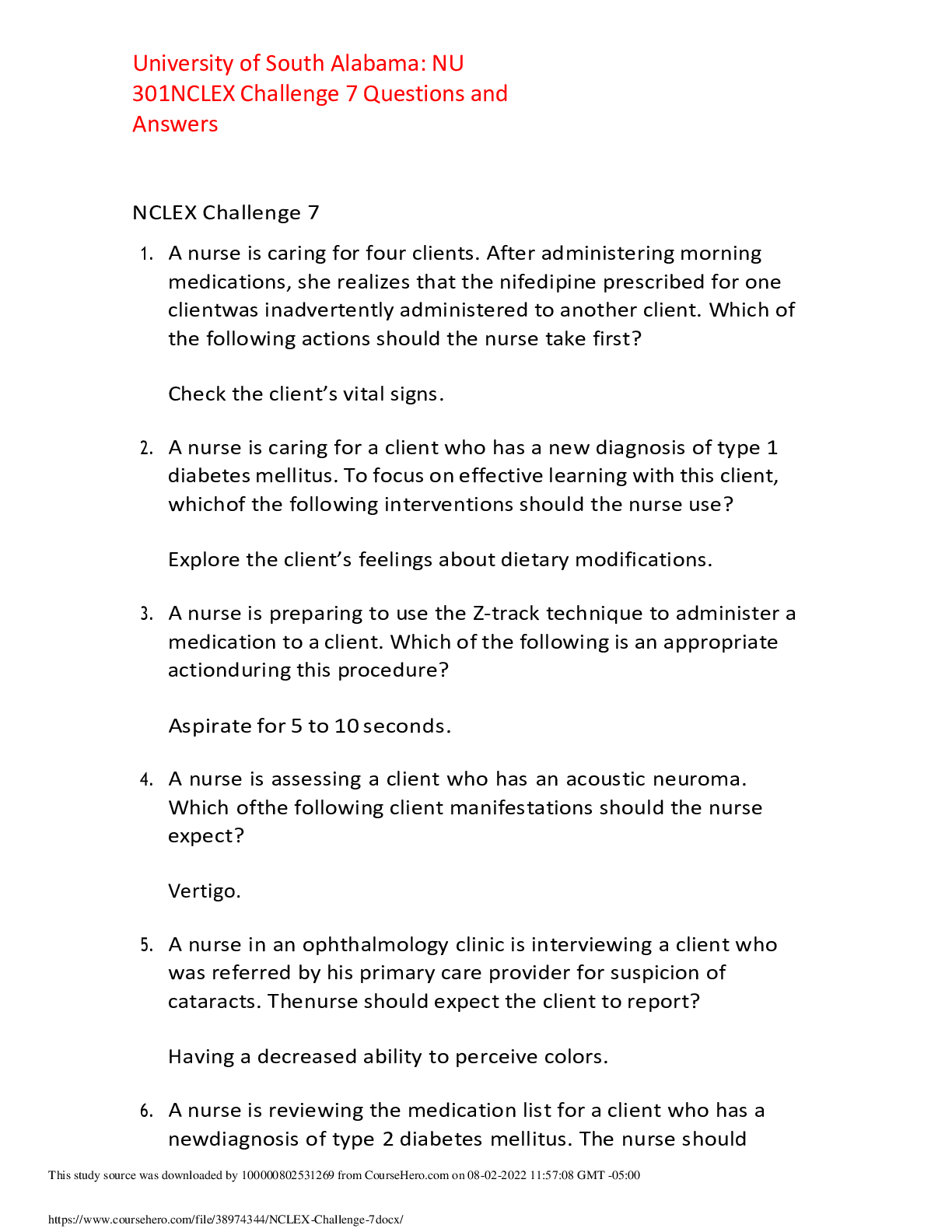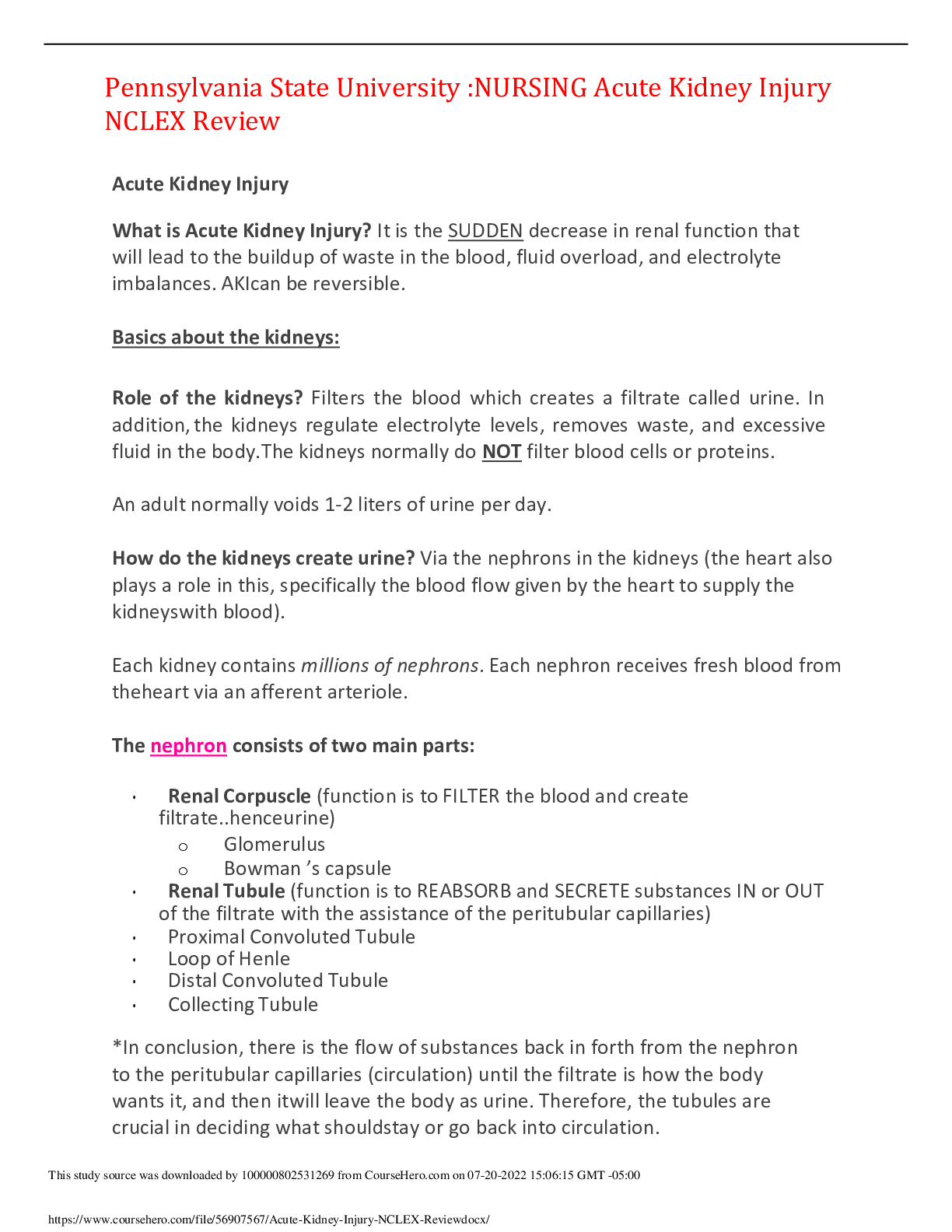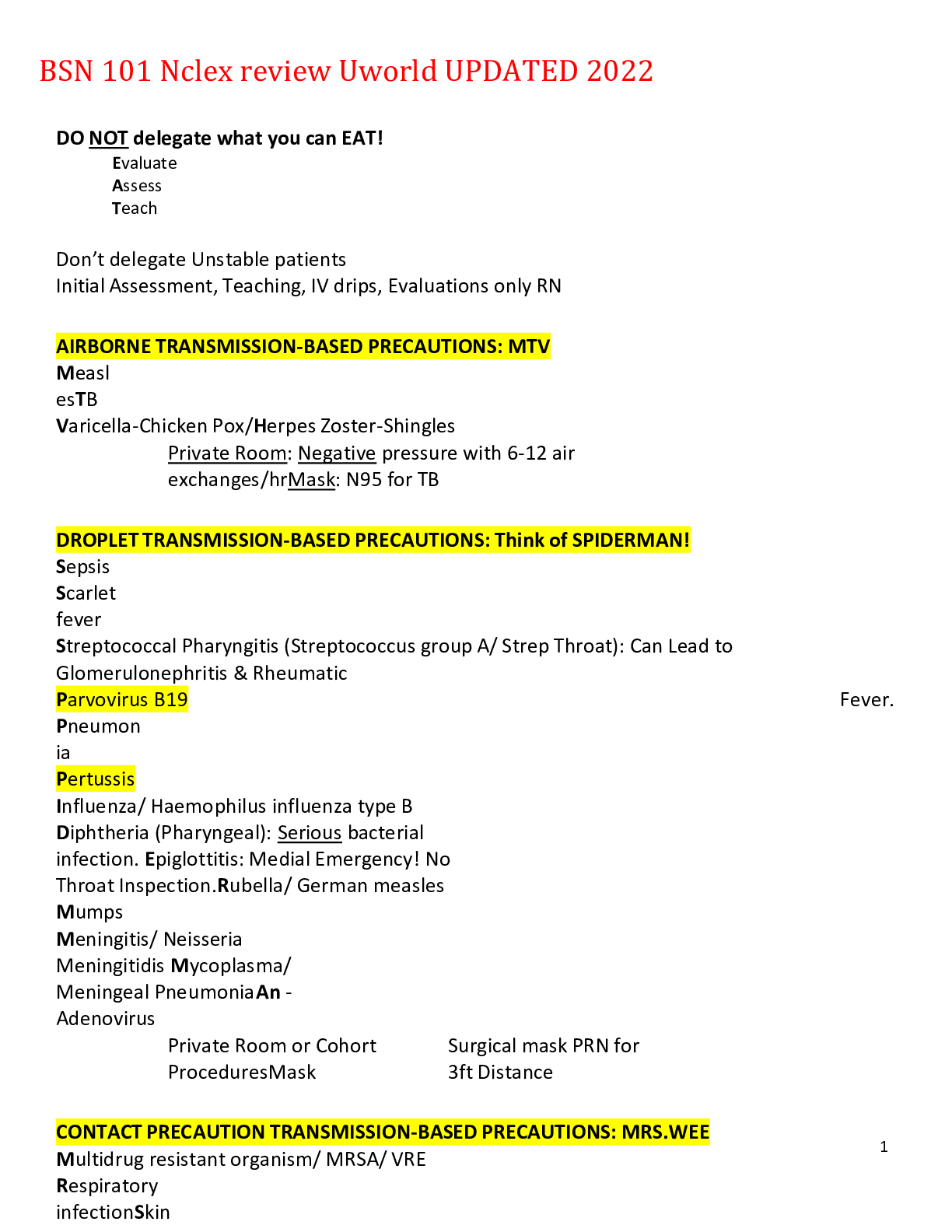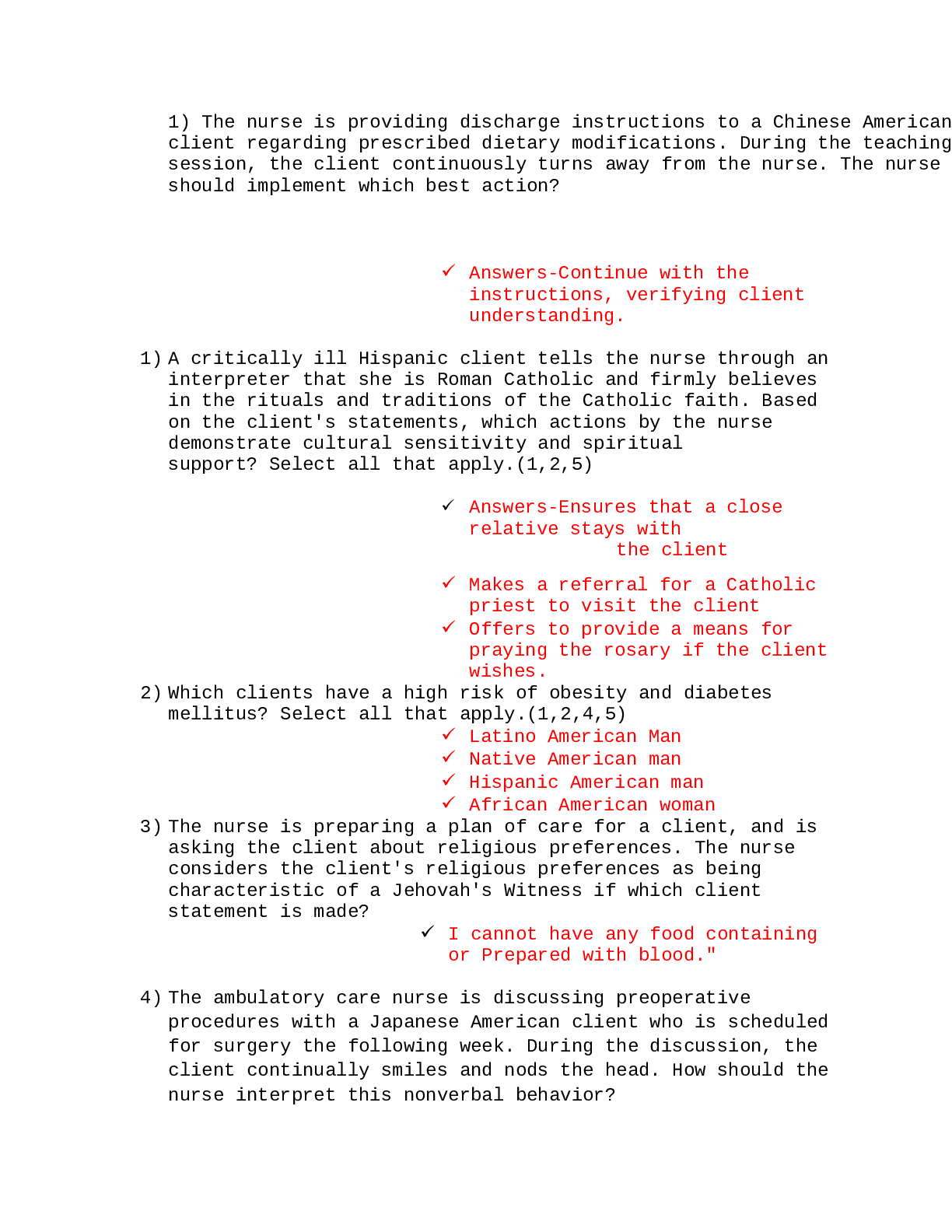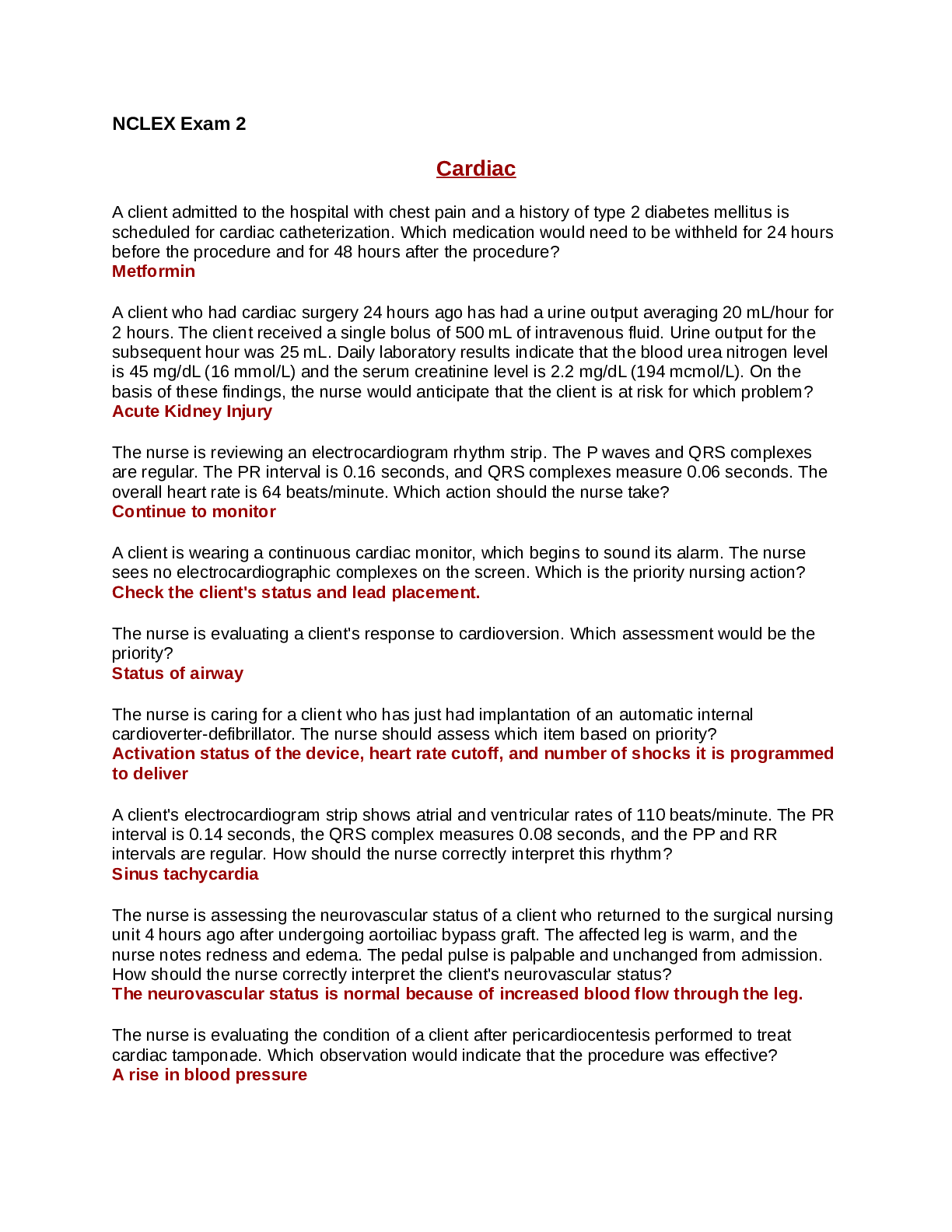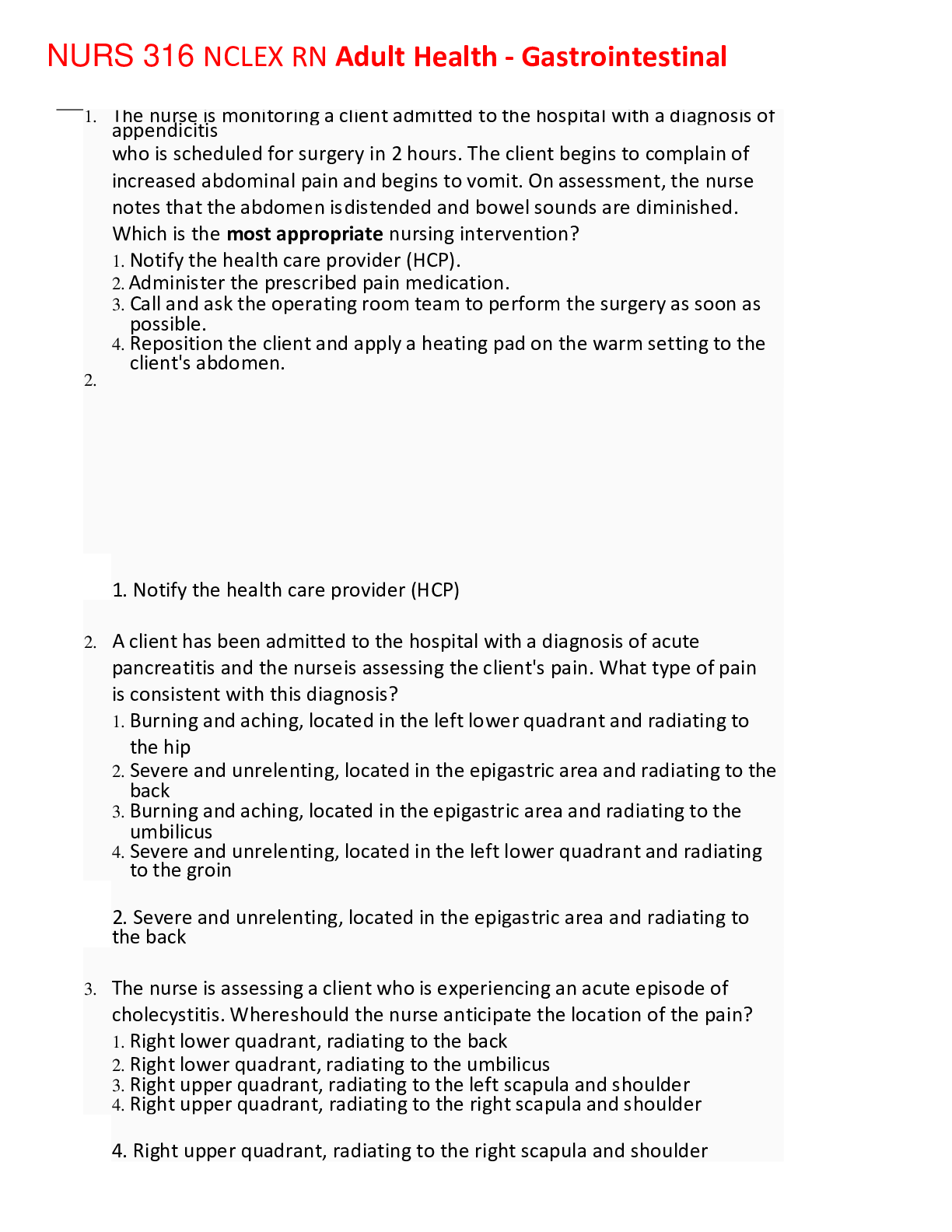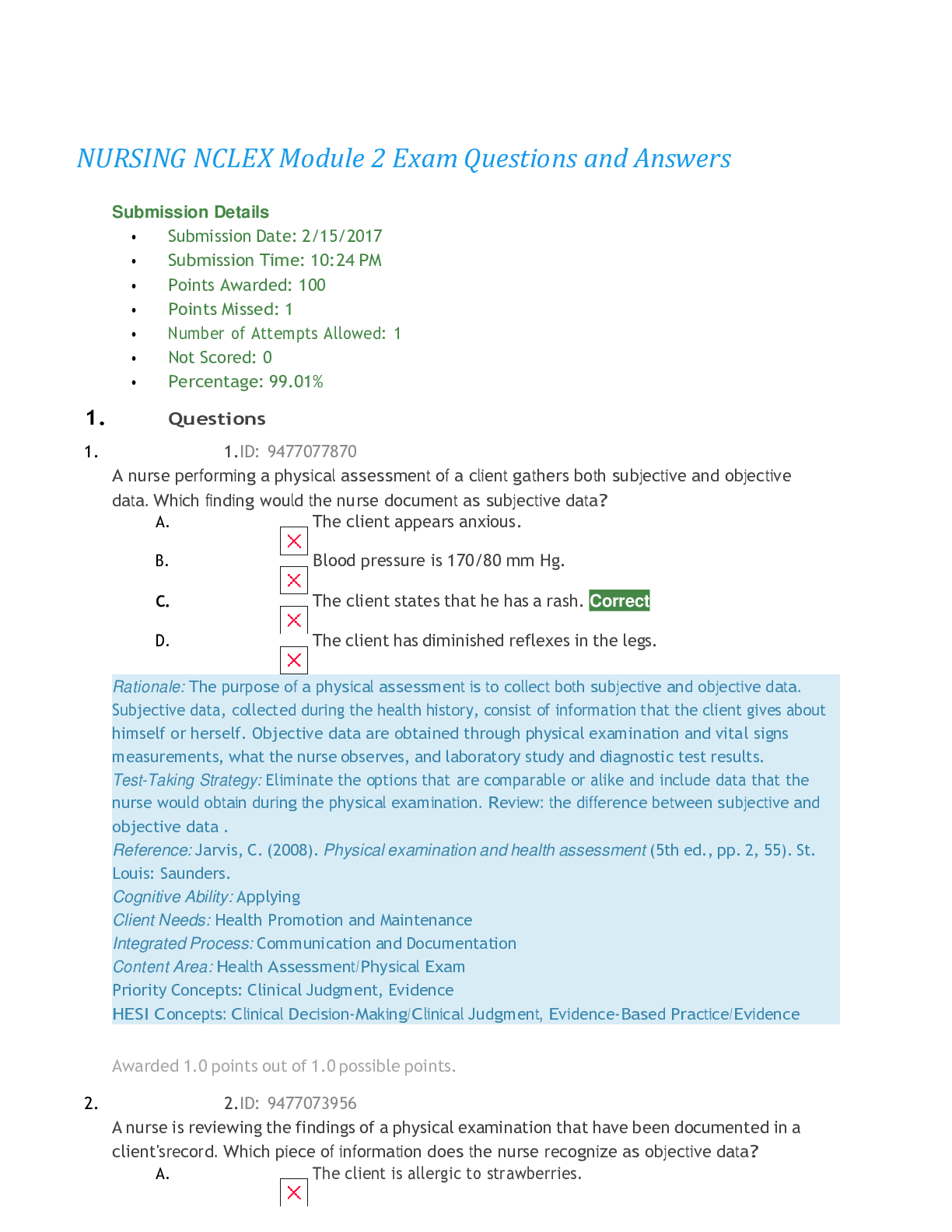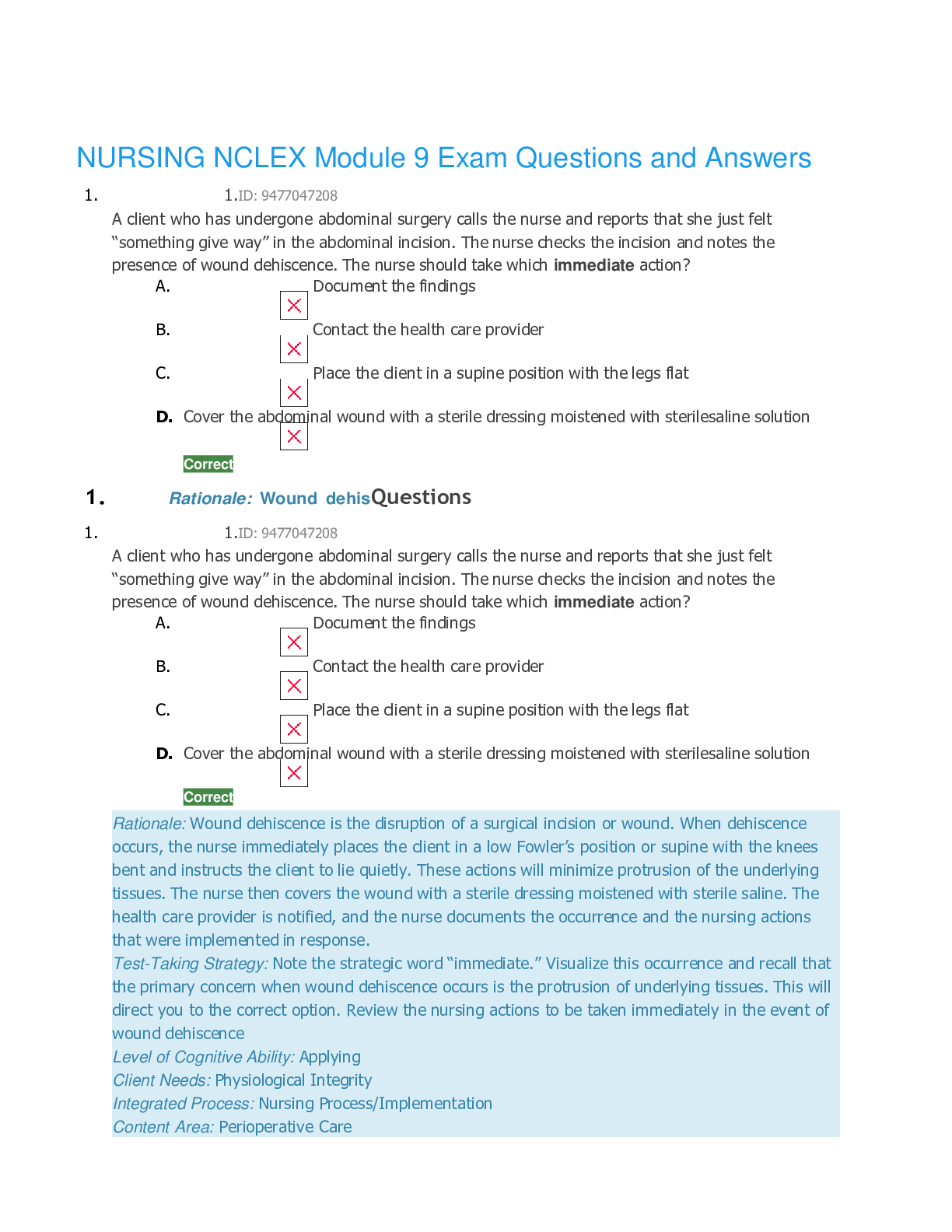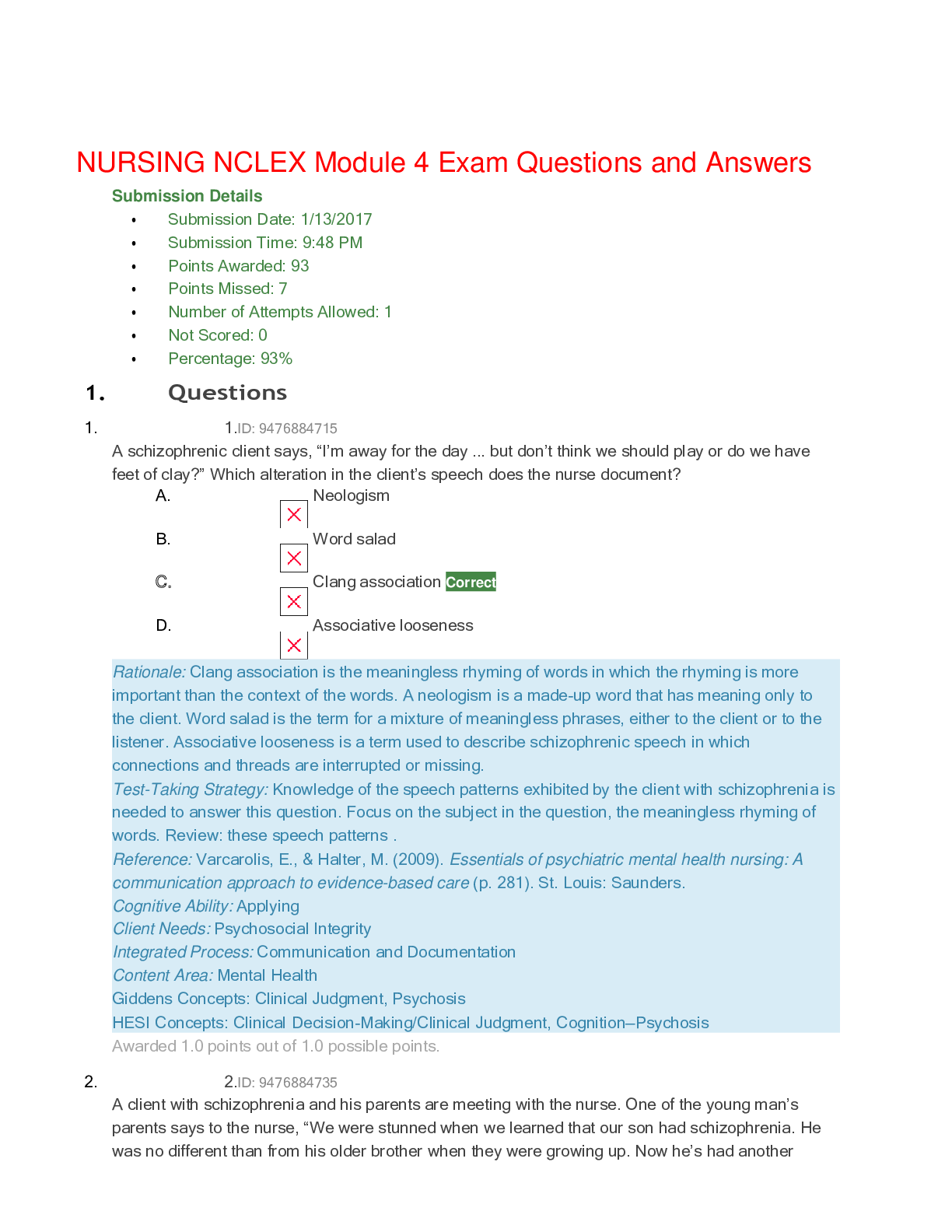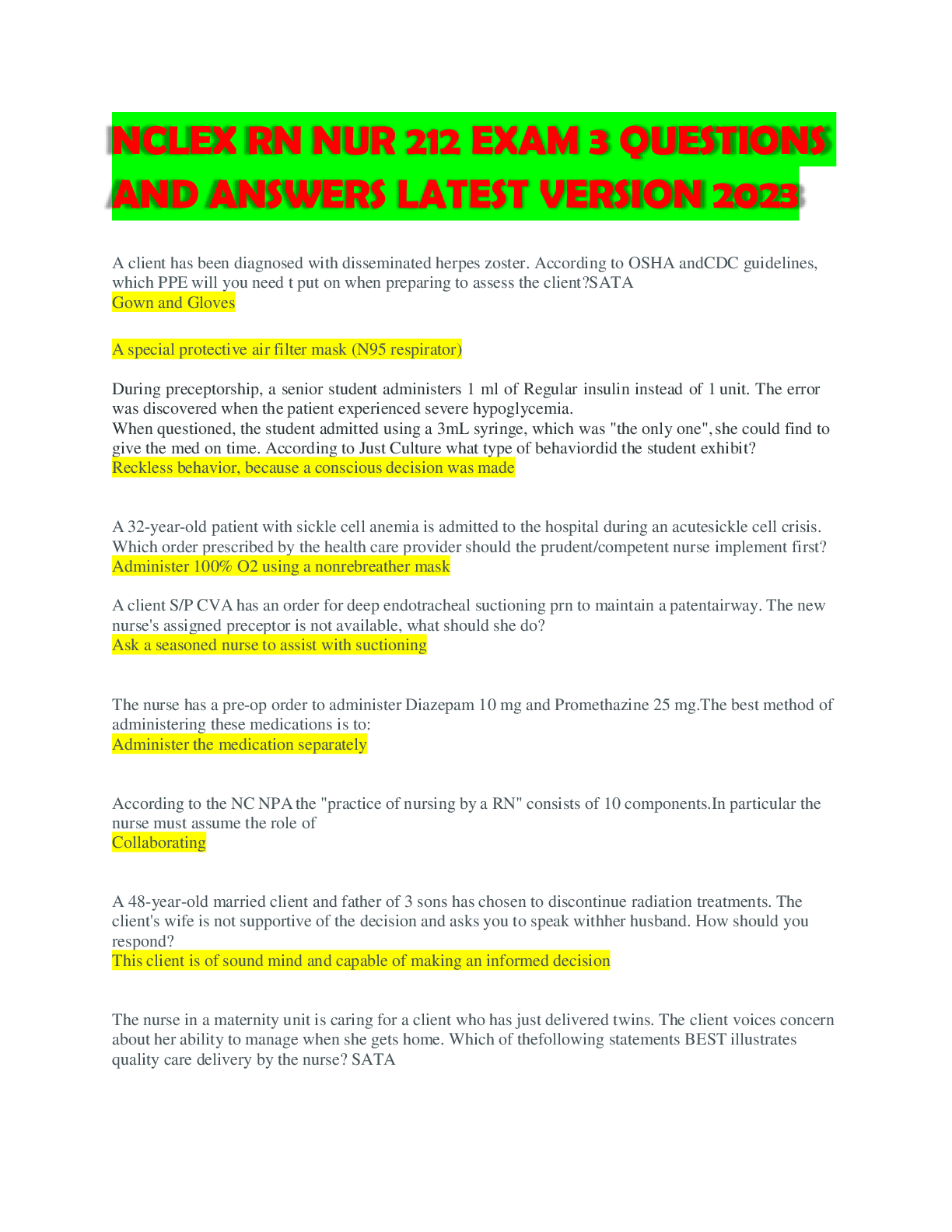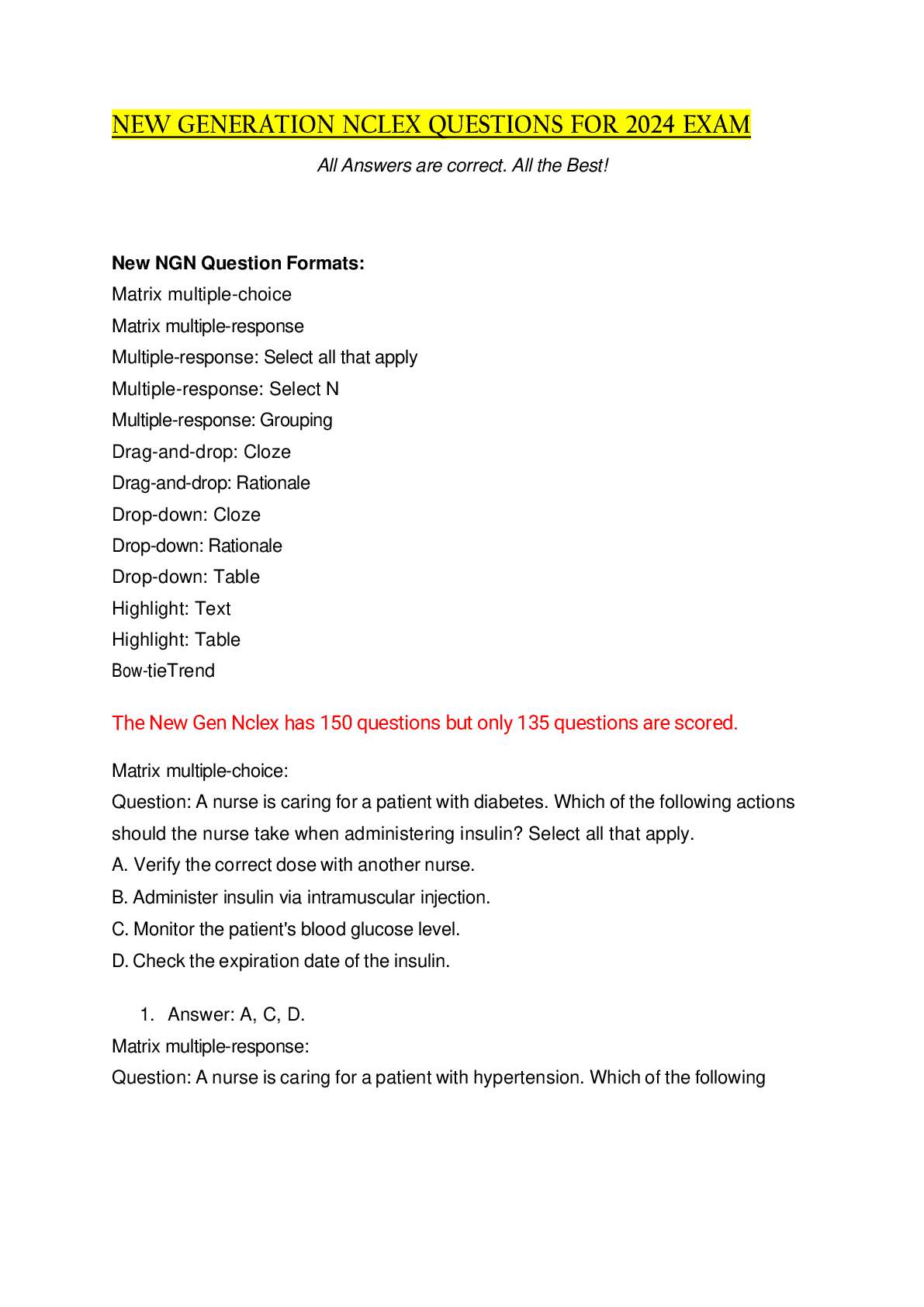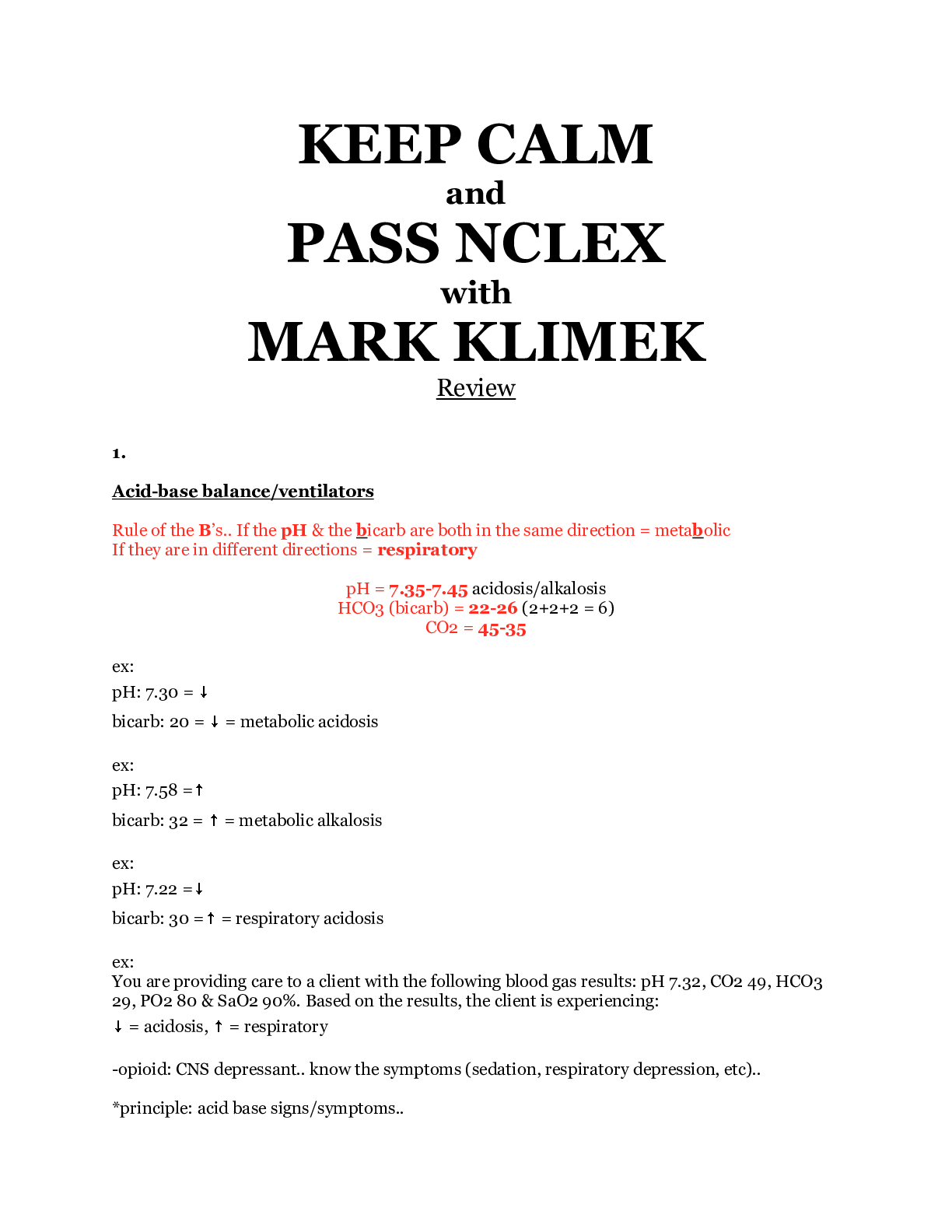*NURSING > NCLEX > University of South Alabama: NU 301 NCLEX Challenge 3 Questions and Answers,100% CORRECT (All)
University of South Alabama: NU 301 NCLEX Challenge 3 Questions and Answers,100% CORRECT
Document Content and Description Below
University of South Alabama: NU 301NCLEX Challenge 3 Questions and Answers NCLEX Challenge 3 1. A nurse is preparing to administer clindamycin 300 mg by intermittent IV bolus over 30 min to a cl... ient who has staphylococci infection. Available is clindamycin premixed in 50 mL 0.90% sodium chloride (NaCl). The nurse should set the IV pump to deliver how many mL/hr? (Round the answer to the nearest whole number). 100 mL/hr 2. A nurse is preparing to administer 0.9% sodium chloride (NSS) 3000 mL IV to infuse over 24 hr. The drop factor on the manual IV tubing is 10 gtt/mL. The nurse should set the manual IV infusion to deliver how many gtt/min? (Round the answer to the nearest whole number). 21 gtt/min 3. A nurse in the emergency department is caring for a client who collapsed after playing football on a hot day. After reviewing the admission laboratory findings, the nurse recognizes that these findings are consistent with which of the following conditions? Sodium 152 Potassium 3.6 Chloride 105 Glucose 102 BUN 18 Creatinine 0.7 Dehydration 4. A nurse is calculating a client’s intake and output for an 8-hr shift. The client’s intake included 1,000 mL 0.9% sodium chloride IV, one 6-oz cup of coffee, 6 oz of water, one 180-mL bowl of soup; 3 oz of flavored gelatin, and 3 oz of ice cream. How many mL should the nurse document as the client’s total intake for the shift? (Round the answer to the nearest whole number). 1,720 mL 5. A nurse is caring for a client whose arterial blood gas results show a pH of 7.3 and a PaCO2 of 50 mm Hg. The nurse should identify that the client is experiencing which of the following acid-base imbalances? Respiratory acidosis 6. A nurse is planning care for a client who has dehydration and is receiving a continuous IV infusion of 0.9% sodium chloride. Which of the following interventions should the nurse include in the plan of care? Check the client’s IV infusion every 8 hr. 7. A nurse is teaching a client who will undergo a bronchoscopy procedure. The provider will use a rigid scope and general anesthesia. The nurse should explain that the client’s neck will be in which of the following positions? A hyperextended position 8. A nurse is assessing a client who has fluid overload. Which of the following findings should the nurse expect? (Select all that apply.) Increased heart rate Increased blood pressure Increased respiratory rate 9. A nurse is teaching a client who is obese and has obstructive sleep apnea how to decrease the number of nightly apneic episodes. Which of the following client statements indicates an understanding of the teaching? “If I could lose about 50 pounds, I might stop having so many apneic episodes.” 10. A nurse is caring for a client who is in the immediate postoperative period following a partial laryngectomy. Which of the following parameters should the nurse assess first? Airway patency 11. A nurse is assessing for cyanosis in a client who has dark skin. Which of the following sites should the nurse examine to identify cyanosis in this client? Conjunctiva 12. A nurse is caring for a client scheduled to receive external radiation to the neck for cancer of the larynx. During a pre-treatment exam, the nurse explains to the client that the most likely side effect would be Dysphagia 13. A nurse is providing teaching to a group of adult athletes about preventing the effects of dehydration on the body. Which of the following manifestations should the nurse include in the teaching? Impaired motor control 14. A nurse is caring for a client who is receiving IV fluids to correct dehydration. Which of the following laboratory values should indicate to the nurse that the client is effectively responding to treatment? Urine specific gravity 1.020 15. A nurse is assessing four clients for fluid balance. The nurse should identify that which of the following clients is exhibiting manifestations of dehydration? A client who has a temperature of 39°C (102°F) 16. A nurse is caring for a client who is receiving oxygen at 2 L/min via a nasal cannula. The nurse recognizes the client is receiving which of the following inspired oxygen concentration? 28% 17. A nurse is attending a social event when another guest coughs weakly once, grasps his throat with his hands, and cannot talk. Which of the following actions should the nurse take? Perform the Heimlich maneuver 18. A nurse is caring for a client who is postoperative and whose respirations are shallow and 9/min. Which of the following acid-based imbalances should the nurse identify the client as being at risk for developing initially? Respiratory acidosis 19. A nurse is caring for a client who develops an airway obstruction from a foreign body but remains conscious. Which of the following actions should the nurse take first? Administer the abdominal thrust maneuver 20. A nurse is reviewing the medical record of a client who has a potassium level of 3.0 mEq/L. Which of the following findings should the nurse recognize as a potential causative factor? Client has a NG tube to gastric suction 21. A nurse is caring for a client who is receiving oxygen therapy via a nasal cannula. The nurse explains to the client that this method of oxygen delivery doses which of the following? Delivers a low concentration of oxygen 22. A nurse is caring for a client who had total thyroidectomy and a serum calcium level of 7.6 mg/dL. Which of the following findings should the nurse expect? Tingling of the extremities 23. A nurse is preparing to suction a client who has a tracheostomy. Identify the sequence of actions the nurse should take. Adjust the suction Don sterile gloves Check the function of the suction catheter Hyperoxygenate the client Insert the catheter without suction Apply suction while rotating the catheter Assess for secretion clearance 24. A nurse is caring for four hospitalized clients. Which of the following clients should the nurse identify as being at risk for fluid volume deficit? The client who has gastroenteritis and is febrile 25. A client is admitted to the emergency room with a respiratory rate of 7/min. Arterial blood gases (ABG) reveal the following values. Which of the following is an appropriate analysis of the ABGs? pH 7.22 PaCO2 68 mm Hg Base excess -2 PaO2 78 mm Hg Saturation 80% Bicarbonate 26 mEq/L Respiratory acidosis 26. A nurse is monitoring an older adult client immediately following a bronchoscopy. The nurse’s priority is to monitor the client for which of the following? Confirming the gag reflex 27. A client who is receiving magnesium sulfate has a urine output of 20 mL/hr. Which of the following medications should the nurse expect to administer? Calcium gluconate 28. A nurse is caring for a client who has a tracheostomy. Which of the following interventions should the nurse implement when performing tracheostomy care? Secure new tracheostomy ties before removing old ones 29. A nurse is preparing to administer 40 mEq of potassium chloride in 45% sodium chloride (NaCl) 500 mL IV to infuse 10 mEq/hr. The nurse should set the IV pump to deliver how many mL/hr? (Round the answer to the nearest whole number). 125 mL/hr 30. A nurse is performing tracheostomy care for a client and suctioning to remove copious secretions. Which of the following actions should the nurse take? Suction two to three times with a 60-sceond pause between passes 31. A nurse is assessing a client who has a sodium level of 116 mEq/L. Which of the following findings should the nurse expect? Nausea and vomiting 32. A nurse is calculating the intake of a client during the past 9 hr. The client’s intake includes lactated Ringer’s IV at 150 mL/hr, cefazolin 2 g IV intermittent bolus in 100 mL of 0.9% sodium chloride, two units of packed RBCs of 275 mL and 250 mL; two IV bolus infusions of 250 mL of 0.9% sodium chloride, ranitidine 50 mg IV intermittent bolus in 50 mL of dextrose 5% in water. How many mL of intake should the nurse record? 2,525 mL 33. A nurse is assessing a client who is taking chlorothiazide sodium. The nurse recognizes which of the following as a manifestation of hypokalemia? Shallow respirations 34. A nurse is completing the 8-hr I&O record for a client who consumed 4 oz of clear soda, 1 piece of toast, 12 oz of water, 1 cup of fruit-flavored gelatin, and ½ cup of chicken broth. The client also received 300 mL of 0.9% sodium chloride IV. The nurse should record how many mL of intake on the client’s record? (Round the answer to the nearest whole number). 1,140 mL 35. A nurse is caring for a client who has a prescription for potassium chloride (KCL) 20 mEq PO daily. The nurse reviews the client’s most recent laboratory results and finds the client’s potassium level is 5.2 mEq/L. Which of the following actions should the nurse take? Call the prescribing physician and inform her of the client’s serum potassium level results 36. A nurse is auscultating a client’s lung sounds and identifies crackles in the left lower lobe. Which of the following interventions should the nurse take? Repeat auscultation after asking the client to breathe deeply and cough 37. A nurse is caring for a female client in the emergency department who reports shortness of breath and pain in the lung area. She states that she started taking birth control pills 3 weeks ago and that she smokes. Her heart rate is 110/min, respiratory rate 40/min, and blood pressure 140/80 mm Hg. Her arterial blood gases are pH 7.50, PaCO2 29 mm Hg, PaO2 60 mm Hg, HCO3 20 mEq/L, and SaO2 86%. Which of the following is the priority nursing interventions? Administer oxygen via face mask 38. A nurse is planning the discharge of a client who has sleep apnea and requires bi-level positive airway pressure (BiPAP) at night. The nurse should plan to consult with which of the following health care team members to help educate the client? Respiratory therapist 39. As part of an annual physical examination, a nurse is preparing a client to undergo a chest x-ray. Which of the following instructions should the nurse give the client prior to the procedure? Remove all metal necklaces 40. A nurse is caring for a client who has hypertension and develops epistaxis. Which of the following actions should the nurse take? (Select all that apply.) Apply pressure to the nares Place ice to the bridge of the client’s nose Move the client into high-Fowler’s position 41. A nurse is caring for a client who has a serum potassium level of 5.5 mEq/L. The provider prescribes polystyrene sulfonate. If this medication is effective, the nurse should expect which of the following changes on the client’s ECG? Reduction of T-wave amplitude 42. A nurse is caring for a client who experienced a lacerated spleen and has been on bedrest for several days. The nurse auscultates decreased breath sounds in the lower lobes of both lungs. The nurse should realize that this finding is most likely an indication of which of the following conditions? Atelectasis 43. A nurse is teaching a client who has chronic kidney disease about limiting foods that are high in potassium. Which of the following foods should the nurse instruct the client to avoid? (Select all that apply). Tomatoes Bananas Raisins 44. A nurse is instructing a group of clients regarding calcium rich foods. Which of the following foods should the nurse include in the teaching as the best source of calcium? 1 cup milk 45. A nurse is providing discharge teaching for a client who requires home oxygen therapy. Which of the following statements should the nurse identify as an indication that the client needs further teaching? “I will wear synthetic clothing and woolen socks when using my oxygen.” 46. A nurse is assessing a client prior to administering a seasonal influenza vaccine. The client says he read about an influenza vaccine that is given as a nasal spray and wants to receive it. The nurse should recognize that which of the following findings is a contraindication for the client receiving the live attenuated influenza vaccine (LAIV)? The client’s age is 62 47. A nurse is reviewing the arterial blood gas values for a client. The pH is 7.32, PaCO2 48 mm Hg and the HCO3 is 23 mEq/L. The nurse should recognize that these findings indicate of which of the following acid base balances? Respiratory acidosis 48. A nurse is preparing to measure a client’s level of oxygen saturation and observes edema of both hands and thickened toe nails. The nurse should apply the pulse oximeter probe to which of the following locations? Earlobe 49. A nurse in a PACU is admitting a client who is postoperative following a tonsillectomy. Which of the following actions should the nurse plan to take to prevent aspiration? Withhold fluids until the client demonstrates a gag reflux 50. A nurse is caring for a client with a tracheostomy. The client’s partner has been taught to perform suctioning. Which of the following actions by the partner should indicate to the nurse a readiness for the client’s discharge? Performing the procedure independently 51. A nurse is caring for a client who is 1-day postoperative following a total laryngectomy and has begun a soft diet. The client is not eating well and tells the nurse that the hospital food has no taste. Which of the following responses is appropriate for the nurse to make? “Because of your surgery, you have an altered ability to smell and taste.” [Show More]
Last updated: 1 year ago
Preview 1 out of 17 pages
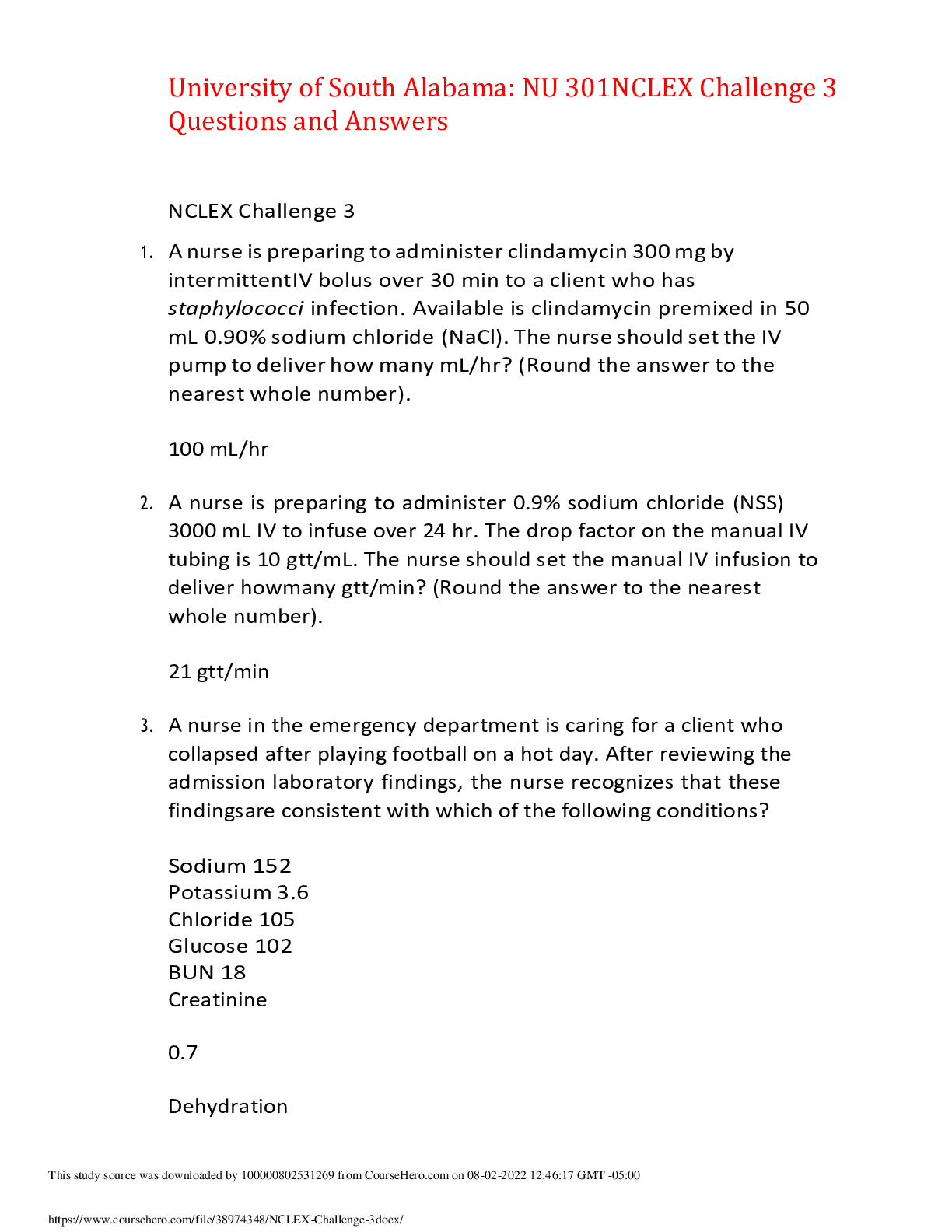
Reviews( 0 )
Document information
Connected school, study & course
About the document
Uploaded On
Aug 02, 2022
Number of pages
17
Written in
Additional information
This document has been written for:
Uploaded
Aug 02, 2022
Downloads
0
Views
44

